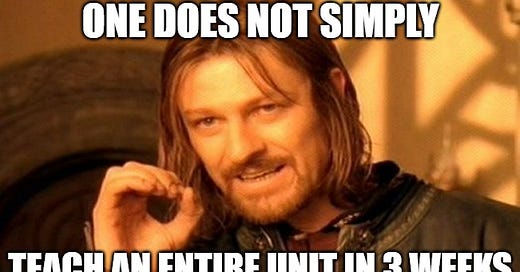Making the Most of December
In teaching, the stretch between Thanksgiving Break and Winter Break is an odd time. We are left with three to four weeks until the next break, with a good chunk of it filled with mid-year testing and seasonal events. Furthermore, as the holidays get closer it seems as if students motivation levels drop like the weather. Though it can be a cheerful and fun time of the year, it can tend to feel unproductive if we are not intentional.
To help provide some motivation and goals for you and your students, here are some tips on how to make the best out of the short stretch of time in schools called December.
1. Tighten up and revisit classroom expectations and procedures
As the year goes on, we get to know our students better and become more familiar with their behaviors. We also begin to relax and become lazier with our classroom procedures and expectations (or maybe just me?). However, it is important to continue holding students accountable and upholding expectations of your classroom for a positive learning environment.
Spending 5 to 10 minutes revisiting expectations and procedures after a break can go a long way. Coming off of a break, students tend to forget or disregard previous expectations set (Honestly, I will never believe that they forget. They know them). Give them no doubt that they still exist, and even practice them if needed.
2. Review, review, review
Three to four weeks is not a ton of time to finish a Unit. Many Units can take up to 6 to 8 weeks to finish, and rushing through one in half the amount of time does not leave a ton of time to practice. Furthermore, having to pause mid unit and return back to it after break can be a nightmare.
Depending on the control that you have over your curriculum at your school, spending more time reviewing than introducing new concepts can be extremely beneficial to students. It takes more than once seeing a concept to solidify learning. Students need multiple opportunities to practice a skill in order to master it. Therefore, spending a few days reteaching or reinforcing old concepts is a great way to solidify the previous knowledge before students head into a long break.
3. Mini Unit
If time is really short and I have a good chunk of content I need to cover, I will do a Mini Unit. It is a condensed down Unit where only major topics and standards are covered, and smaller standards are left behind. For instance, when I teach simplifying radicals and quadratic equations I usually have a lesson or two on complex numbers. It is a smaller standard that students are not tested on, but will be helpful to know for future classes. If needed, I can cut it out and no harm is done. When the end of the year comes back around, I can always just plug it in then so that students learn it.
4. Project Based Learning
I am not a fan of large projects, but I do believe that December is an excellent time of the year to do a project. There is an adequate amount of content covered in a class by December, so doing a project on previous learning is a great way for students to apply their knowledge from past Units. Furthermore, you could take a Project Based Learning approach and have students learn new content from your “December Project”.
5. Differentiate your classroom with online tools
December is also a great month to try out differentiating. By now, it is very obvious the students who are behind, on track, or ahead on the content in the class. You can utilize the month to assign students to a skill level that meets their current ability. For instance, you can assign Khan Academy or Delta Math assignments to your students on skills that the need to either develop or review. Furthermore, you can focus on pulling smaller groups to teach them the content. This allows for all students to address gaps or advanced further on content specific to them.
I hope these tips are fruitful in helping you plan this December. Let me know what you plan on doing this December with your students below.




